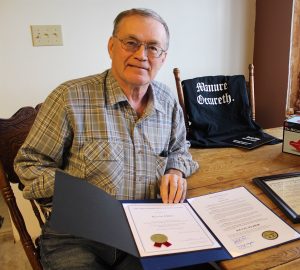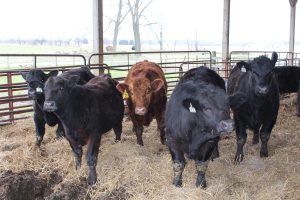COLUMBUS — Taking care of the land and practicing conservation have been part of the Elder family for about as long as anyone can remember.
Kevin Elder, 65, said his father had a conservation plan for their farm as early as 1951. Sitting at his kitchen table, Elder points to grass waterway he built in 1976, as one of his first projects as an employee of the Fairfield Soil and Water Conservation District.
It’s one of many improvements Elder made during his 40-plus years of professional natural resources conservation, which included leadership positions in the Ohio Department of Natural Resources, and the Ohio Department of Agriculture, where he retired in March.
But for Elder, everything started on the family farm. He learned how to milk cows by hand and how to drive tractor with a John Deere B and a Farmall H. He also learned how to take care of a wide range of livestock, including beef and dairy cattle, swine, poultry and sheep.
Working local
For the first 10 years of his career, he helped landowners in Fairfield County with their conservation plans, drainage tile, and manure storage. He enjoyed the connections he made within his own county, being able to work with the people he knew.
In 1986, he was asked to join the Department of Natural Resources, to lead the department’s pollution abatement program.
It was a big step, going from just one county to all 88 counties.
“I still look at some of the projects around (Fairfield County) that I was involved with. It felt good to help put conservation practices out there on the land, and I lost some of that (connection) when I went to the state office,” Elder said.
Taking action
But it was a job that needed done, and arguably, one that needed someone familiar with agriculture. At the state level, Elder handled pollution complaints, updated the rules for ag pollution and abatement, and helped create the rules for livestock mortality composting.

“When I went to Columbus, I got involved in a lot of pollution complaints,” he said. “We tried to get everything done and approved voluntarily, but there were some that wouldn’t make corrective actions.”
Regulating manure
In the 1990s, many of the complaints dealt with large livestock farms that were expanding, especially poultry farms. At the time, the Ohio EPA oversaw the permit to install, but Elder said the state didn’t have an ongoing “permit to operate.”
This left the rules unclear after a livestock facility was built, from both a regulatory and environmental standpoint.
Elder said the other issue was that EPA staff didn’t always understand agriculture. This disconnect led to the formation of a new division within ODA, that would not only oversee permits to install, but also define and enforce permits to operate. Known as the division of Livestock Environmental Permitting, Elder led the new program from 2001 to his retirement.
Although he seemed like a natural fit, Elder said he was hesitant at first. It was a big undertaking, to lead a new division, especially one that dealt with regulating farms in the private and public eye.
“I talked to Mom and Dad at the time, around the kitchen table, and they said ‘you’re crazy if you take that,’” Elder recalled.
But Elder decided the move was right.
“Livestock was needed in Ohio and I wanted to see it done properly,” he said.
“It (manure) was something to get rid of; it was considered a waste, and my goal was to try and change some of that,” said Elder, who graduated from Ohio State University with an animal sciences degree in 1975.
Putting it together
With a pencil and a newly created job, Elder went to work, choosing his staff, and working with Ohio’s many stakeholders to write new rules for livestock operations.
An advisory group was formed, and 16 meetings were held in about eight months. The end result was six chapters and 240 rules.
The underlying goal was to educate livestock producers about what they needed to be doing, and bring them into compliance. Over time, Elder said many farmers actually thanked him for the new rules, because they gave farmers a standard to follow, and guidance about how to handle sensitive environmental issues.
“We tried to get people to understand what they needed to do to manage their facility better,” he said.
State law requires facilities to be permitted with ODA if they meet or exceed certain capacity thresholds. For mature dairy cows, the capacity is 700 head; for beef cattle, 1,000 head; hogs, 2,500; baby pigs, 10,000; layers, 82,000; and broilers, 125,000.
Fewer complaints
Elder said one of the program’s greatest success stories was reducing the number of complaints. In the beginning, almost every permit resulted in a public meeting, with some drawing 500-600 concerned people. Today, with better understanding and more compliance, there are fewer complaints and fewer violations.
David Daniels, director of the Ohio Department of Agriculture, said Elder is the reason for the program’s success, calling him “a guy that practices the environmental programs that he preaches.”
Daniels said environmental permitting can be an emotional process, but Elder made sure it was science-based, earning the “respect and admiration” of the farmers.
Looking ahead
Universities are also doing a better job of educating students about manure, Elder said, and he continues to work with university staffers about new research regarding how manure is applied to crops.
“I think one of the main things we need to think about is putting the nutrients into the soil and getting them below the surface,” he said. “It needs to be below that rainfall impact.”

Kevin continues to farm with his brother, Karl, and together they crop farm about 1,800 acres and finish a dozen head of beef cattle.
His family has been farming in the same area since the 1830s. With more time on his hands, Kevin hopes to continue making improvements, and maintaining the conservation projects that were started many years before.











I was compelled to respond because the article “A champion for conservation” did not ring true to me. Kevin Elder may have been a conservation champion when he worked for the ODNR – but I agree with his statement “I lost some of that when I went to the state office [ODA].”
The new ODA rules for concentrated animal feeding operations (a.k.a. factory farms) were written by a group of scientists, agency representative, farmers, and environmentalists, but Elder and the advisory group added loopholes and director’s discretion to this program and thus, it eventually became a sham. Instead of a 200+page manure management plan, many/most MMPs were reduced to just one sentence – all the manure will be sold to others. No soil tests, no five-year plan to utilize the nutrients, no oversight.
The reason there are now fewer complaints is because of Ohio’s unlawful split CAFO permitting scheme – ODA claimed violations should be investigated by Ohio EPA whereas, Ohio EPA claimed ODA had the authority. Ultimately, most people stopped filing complaints.
In fact, it has been almost 18 years since the legislature approved the split CAFO permitting programs, but U.S. EPA has never approved any transfer of authority over CAFOs – which are deemed point sources of pollution under the Clean Water Act.
Animal manure is a major contributor to the toxic algae in Ohio’s lakes and rivers quite simply because Ohio’s laws do not comply with the Clean Water Act. According to a recent report by the Ohio Environmental Council – “The number one cause of toxic algae in Lake Erie is the overabundance of phosphorus coming from crop fields in the lake’s watershed. With manure applied excessively over 70 percent of the time, it’s clear more needs to be done to address this critical problem that puts water sources at risk.”
Sadly, Lake Erie and other Ohio lakes are doomed because Kevin Elder was captured by the very industry he was supposed to regulate.